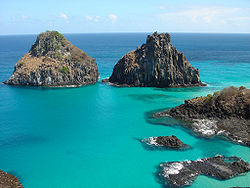Sand


Sand is a naturally occurring granular material composed of finely divided rock and mineral particles. The composition of sand is highly variable, depending on the local rock sources and conditions, but the most common constituent of sand in inland continental settings and non-tropical coastal settings is silica (silicon dioxide, or SiO2), usually in the form of quartz.
As the term is used by geologists, sand particles range in diameter from 0.0625mm (or 1⁄16 mm, or 62.5 micrometers) to 2 millimeters. An individual particle in this range size is termed a sand grain. The next larger size class above sand is gravel, with particles ranging from 2 mm up to 64 mm (see particle size for standards in use). The next smaller size class in geology is silt: particles smaller than 0.0625 mm down to 0.004 mm in diameter. The size specification between sand and gravel has remained constant for more than a century, but particle diameters as small as 0.02 mm were considered sand under the Albert Atterberg standard in use during the early 20th century. A 1953 engineering standard published by the American Association of State Highway and Transportation Officials set the minimum sand size at 0.074 mm. A 1938 specification of the United States Department of Agriculture was 0.05 mm.[1] Sand feels gritty when rubbed between the fingers (silt, by comparison, feels like flour).
ISO 14688 grades sands as fine, medium and coarse with ranges 0.063 mm to 0.2 mm to 0.63 mm to 2.0 mm. In the United States, sand is commonly divided into five sub-categories based on size: very fine sand (1⁄16 - ⅛ mm diameter), fine sand (⅛ mm - ¼ mm), medium sand (¼ mm - ½ mm), coarse sand (½ mm - 1 mm), and very coarse sand (1 mm - 2 mm). These sizes are based on the Krumbein phi scale, where size in Φ = -log base 2 of size in mm. On this scale, for sand the value of Φ varies from -1 to +4, with the divisions between sub-categories at whole numbers.
Contents |
Constituents
.jpg)
The most common constituent of sand, in inland continental settings and non-tropical coastal settings, is silica (silicon dioxide, or SiO2), usually in the form of quartz, which, because of its chemical inertness and considerable hardness, is the most common mineral resistant to weathering.

The composition of sand is highly variable, depending on the local rock sources and conditions. The bright white sands found in tropical and subtropical coastal settings are eroded limestone and may contain coral and shell fragments in addition to other organic or organically derived fragmental material.[2] The gypsum sand dunes of the White Sands National Monument in New Mexico are famous for their bright, white color. Arkose is a sand or sandstone with considerable feldspar content, derived from the weathering and erosion of a (usually nearby) granitic rock outcrop. Some sands contain magnetite, chlorite, glauconite or gypsum. Sands rich in magnetite are dark to black in color, as are sands derived from volcanic basalts and obsidian. Chlorite-glauconite bearing sands are typically green in color, as are sands derived from basaltic (lava) with a high olivine content. Many sands, especially those found extensively in Southern Europe, have iron impurities within the quartz crystals of the sand, giving a deep yellow color. Sand deposits in some areas contain garnets and other resistant minerals, including some small gemstones.
Environments
Sand is transported by wind and water and deposited in the form of beaches, dunes, sand spits, sand bars and related features. In environments such as gravel-bed rivers and glacial moraines it often occurs as one of the many grain sizes that are represented. Sand-bed rivers, such as the Platte River in Nebraska, USA, have sandy beds largely because there is no larger source material that they can transport. Dunes, on the other hand, are sandy because larger material is generally immobile in wind, and are a distinctive geographical feature of desert environments.
Study


The study of individual grains can reveal much historical information as to the origin and kind of transport of the grain. Quartz sand that is recently weathered from granite or gneiss quartz crystals will be angular. It is called grus in geology or sharp sand in the building trade where it is preferred for concrete, and in gardening where it is used as a soil amendment to loosen clay soils. Sand that is transported long distances by water or wind will be rounded, with characteristic abrasion patterns on the grain surface. Desert sand is typically rounded.
People who collect sand as a hobby are known as arenophiles. Organisms that thrive in sandy environments are psammophiles.
Uses


- Agriculture: Sandy soils are ideal for crops such as watermelons, peaches, and peanuts, and their excellent drainage characteristics make them suitable for intensive dairy farming.
- Aquaria: Sand makes a low cost aquarium base material which some believe is better than gravel for home use.
- Artificial reefs: Geotextile bagged sand can serve as the foundation for new reefs.
- Beach nourishment: Governments move sand to beaches where tides, storms or deliberate changes to the shoreline erode the original sand.[3]
- Brick: Manufacturing plants add sand to a mixture of clay and other materials for manufacturing bricks.
- Car Engine Disablement Sand is also used in addition to Sodium Silicate to inexpensively, quickly, and permanently disable automobile engines.
- Cob: Coarse sand makes up as much as 75% of cob.
- Concrete: Sand is often a principal component of this critical construction material.
- Glass: Sand is the principal component in common glass.
- Landscaping: Sand makes small hills and slopes (for example, in golf courses).
- Paint: Mixing sand with paint produces a textured finish for walls and ceilings or non-slip floor surfaces.
- Railroads: Train operators use sand to improve the traction of wheels on the rails.
- Roads: Sand improves traction (and thus traffic safety) in icy or snowy conditions.
- Sand animation: Performance artists draw images in sand. Makers of animated films use the same term to describe their use of sand on frontlit or backlit glass.
- Sand casting: Casters moisten or oil molding sand, also known as foundry sand and then shape it into molds into which they pour molten material. This type of sand must be able to withstand high temperatures and pressure, allow gases to escape, have a uniform, small grain size and be non-reactive with metals.
- Sand castles: Shaping sand into castles or other miniature buildings is a popular beach activity.
- Sandbags: These protect against floods and gun fire. The inexpensive bags are easy to transport when empty, and unskilled volunteers can quickly fill them with local sand in emergencies.
- Sandblasting: Graded sand serves as an abrasive in cleaning, preparing, and polishing.
- Water filtration: Media filters use sand for filtering water.
- Zoanthid "skeletons": Animals in this order of marine benthic cnidarians related to corals and sea anemones, incorporate sand into their mesoglea for structural strength, which they need because they lack a true skeleton.
Hazards

While sand is generally non-toxic, sand-using activities such as sandblasting require precautions. Bags of silica sand used for sandblasting now carry labels warning the user to wear respiratory protection to avoid breathing the resulting fine silica dust. Material safety data sheets (MSDS) for silica sand state that "excessive inhalation of crystalline silica is a serious health concern".[4]
In areas of high pore water pressure sand and salt water can form quicksand, which is a colloid hydrogel that behaves like a liquid. Quicksand produces a considerable barrier to escape for creatures caught within, who often die from exposure (not from submersion) as a result.
Environmental Issues
Sand's many uses require a significant dredging industry, raising environmental concerns over fish depletion, landslides, and flooding. Countries such as China, Indonesia, Malaysia and Cambodia ban sand exports, citing these issues as a major factor.[5]
See also
- Beach
- Dry quicksand
- Sandstorm
- Heavy mineral sands ore deposits
- Oil sands
- Particle size
- Quicksand
- Sand island
- Sand Rat
- Sandstone
- Singing sand
- Tar sands
- White Sands National Monument
References
- ↑ Urquhart, Leonard Church, "Civil Engineering Handbook" McGraw-Hill Book Company (1959) p.8-2
- ↑ Seaweed also plays a role in the formation of sand
- ↑ Importing Sand, Glass May Help Restore Beaches : NPR
- ↑ Simplot
- ↑ "The hourglass effect". October 8, 2009. http://www.economist.com/world/asia/displaystory.cfm?story_id=14588255. Retrieved October 14, 2009.
External links
- Beach Sand: What It Is, Where It Comes From and How It Gets Here Beaufort County, SC
- ISO
|
||||||||||||||||||||||||||||||||||||||
|
|||||||||||||||||||

